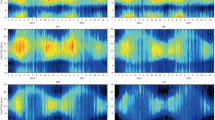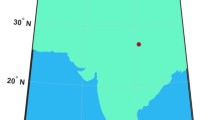Abstract
The F region evening electrodynamics in the equatorial region is characterized by a pre-reversal enhancement (PRE) in the zonal eastward electric field. Although the theoretical mechanisms for PRE are known, its variability, particularly day-to-day variability is not fully resolved. PRE is a large scale phenomenon driven by the F region dynamo after the sunset hours. This paper investigates whether the variability of the E region conductivity (particularly the one associated with the sporadic E, Es) has any influence on the F region dynamo and hence on the PRE of zonal electric field. Interestingly, ionosonde observations have indicated a higher occurrence of the blanketing type Es (Esb) over the low latitude on days with highly suppressed PRE of zonal electric field in comparison with the days with significantly larger PRE. Observational evidences presented in this paper suggests that the formation of the Esb in the evening hours is a sovereign process, not always controlled by the sheared F region vertical electric field of equatorial origin, mapping along the magnetic field line on to the low latitude E region. Model computations of the PRE suppression based on the measured Es densities have further substantiated the observational findings presented in this paper. These results clearly indicate that the low latitude Es has the potential to suppress the PRE of zonal electric field and possibly can play a vital role in explaining the PRE variability, particularly the day-to-day variability. Results have been discussed in light of earlier reports on PRE mechanisms and E-F region coupling processes.






Similar content being viewed by others
Change history
05 April 2018
Correction to: Astrophys Space Sci (2018) 363:72 https://doi.org/10.1007/s10509-018-3288-z
References
Abdu, M.A., MacDougall, J.W., Batista, I.S., Sobral, J.H.A., Jayachandran, P.T.: J. Geophys. Res. 108, 1254 (2003)
Akala, A.O., Doherty, P.H., Valladares, C.E., Carrano, C.S., Sheehan, R.: Radio Sci. 46, RS5018 (2011)
Akala, A.O., Awoyele, A., Doherty, P.H.: Space Weather 14, 233 (2016)
Anderson, D., Haerendel, G.: J. Geophys. Res. 84(A8), 4251 (1979)
Batista, I.S., Abdu, M.A.: J. Geophys. Res. 82(29), 4777 (1977)
Batista, I.S., Abdu, M.A., Carrasco, A.J., Reinisch, B.W., de Paula, E.R., Schuch, N.J., Bertoni, F.: J. Atmos. Sol.-Terr. Phys. 70, 1133 (2008)
Bishop, R.L., Earle, G.D.: J. Geophys. Res. 108(A1), 1019 (2003)
Carrasco, A.J., Batista, I.S., Abdu, M.A.: J. Atmos. Sol.-Terr. Phys. 67, 1610 (2005)
Carrasco, A.J., Batista, I.S., Abdu, M.A.: J. Geophys. Res. 112, A06324 (2007)
Carter, L.N., Forbes, J.M.: Ann. Geophys. 17, 190 (1999)
Chen, C.-H., Lin, C., Chen, W.-H., Matsuo, T.: Geophys. Res. Lett. 44, 1652–1659 (2017)
de Lima, G.R.T., Stephany, S., de Paula, E.R., Batista, I.S., Abdu, M.A., Rezende, L.F.C., Aquino, M.G.S., Dutra, A.P.S.: Space Weather 12, 406 (2014)
Earle, G.D., Bishop, R.L., Collins, S.C., González, S.A., Sulzer, M.P.: J. Geophys. Res. 105(A11), 24951 (2000)
Eccles, J.V.: J. Geophys. Res. 103, 26709 (1998)
Farley, D.T., Bonelli, E., Fejer, B.G., Larsen, M.F.: J. Geophys. Res. 91(A12), 13723 (1986)
Fejer, B.G., dePaula, E.R., González, S.A., Woodman, R.F.: J. Geophys. Res. 96(A8), 13901 (1991)
Fesen, C.G., Crowley, G., Roble, R.G., Richmond, A.D., Fejer, B.G.: Geophys. Res. Lett. 27(13), 1851 (2000)
Gardner, L.C., Schunk, R.W., Scherliess, L., Sojka, J.J., Zhu, L.: Space Weather 12, 675 (2014)
Haerendel, G., Eccles, J.V.: J. Geophys. Res. 97(A2), 1181 (1992)
Heelis, R.A., Kendall, P.C., Moffett, R.J., Windle, D.W., Rishbeth, H.: Planet. Space Sci. 22, 743 (1974)
Heelis, R.A., Crowley, G., Rodrigues, F., Reynolds, A., Wilder, R., Azeem, I., Maute, A.: J. Geophys. Res. 117, A08308 (2012)
Joshi, L.M.: J. Geophys. Res. Space Phys. 121, 6986 (2016)
Joshi, L.M., Sripathi, S.: J. Geophys. Res. Space Phys. 121, 2795 (2016)
Joshi, L.M., Patra, A.K., Rao, S.V.B.: Indian J. Radio Space Phys. 41, 208 (2012)
Joshi, L.M., Patra, A.K., Pant, T.K., Rao, S.V.B.: J. Geophys. Res. Space Phys. 118, 524 (2013a)
Joshi, L.M., Patra, A.K., Rao, S.V.B.: J. Geophys. Res. Space Phys. 118, 1170 (2013b)
Joshi, L.M., Sripathi, S., Singh, R.: J. Geophys. Res. Space Phys. 121, 2489 (2016)
Kelley, M.C.: The Earth’s Ionosphere, 2nd edn. Academic Press, New York (2009)
Kelly, M.A., Comberiate, J.M., Miller, E.S., Paxton, L.J.: Space Weather 12, 601 (2014)
LaBelle, J.: J. Geophys. Res. 90(A5), 4341 (1985)
Mathews, J.D., Bekeny, F.S.: J. Geophys. Res. 84(A6), 2743 (1979)
Oladipo, O.A., Adeniyi, J.O., Olawepo, A.O., Doherty, P.H.: Space Weather 12, 300 (2014)
Picone, J.M., Hedin, A.E., Drob, D.P., Aikin, A.C.: J. Geophys. Res. 107(A12), 1468 (2002)
Richmond, A.D., Fang, T.W.: J. Geophys. Res. Space Phys. 120, 2133 (2015)
Richmond, A.D., Fang, T.W., Maute, A.: J. Geophys. Res. Space Phys. 120, 2118 (2015)
Rishbeth, H.: Planet. Space Sci. 19, 357 (1971)
Roddy, P.A., Earle, G.D., Swenson, C.M., Carlson, C.G., Bullett, T.W.: J. Geophys. Res. 112, A06312 (2007)
Rodrigues, F.S., Crowley, G., Heelis, R.A., Maute, A., Reynolds, A.: J. Geophys. Res. 117, A05307 (2012)
Stephan, A.W., Colerico, M., Mendillo, M., Reinisch, B.W., Anderson, D.: J. Geophys. Res. 107, 1021 (2002)
Tiwari, R., Strangeways, H.J.: Space Weather 13, 72 (2015)
Woodman, R.F.: J. Geophys. Res. 75(31), 6249 (1970)
Yue, X., Schreiner, W.S., Pedatella, N.M., Kuo, Y.H.: Space Weather 14, 285 (2016)
Acknowledgements
Author (L.M.J.) would like to thank Indian Institute of Geomagnetism (IIG) for the award of “Nanabhoy Moos” post doctoral fellowship for the period November 2014–November 2017. Author (L.M.J.) would like to thank S Sripathi of IIG for his active support and encouragement while at IIG. Author (L.M.J.) would like to specially thank A.K. Patra for some valuable discussions on particular aspects of ionospheric electrodynamics and plasma instabilities. Sriharikota ionosonde data utilized in this Paper can be made available to researchers upon request.
The work was supported in part by grant, MOST 106-2111-M-008-019, from the Ministry of Science and Technology, Taiwan, R.O.C.
Authors would like to acknowledge the reviewer of this paper for his valuable comments.
Author information
Authors and Affiliations
Corresponding author
Rights and permissions
About this article
Cite this article
Joshi, L.M., Tsai, L.C. Coupled nature of evening-time ionospheric electrodynamics. Astrophys Space Sci 363, 72 (2018). https://doi.org/10.1007/s10509-018-3288-z
Received:
Accepted:
Published:
DOI: https://doi.org/10.1007/s10509-018-3288-z




